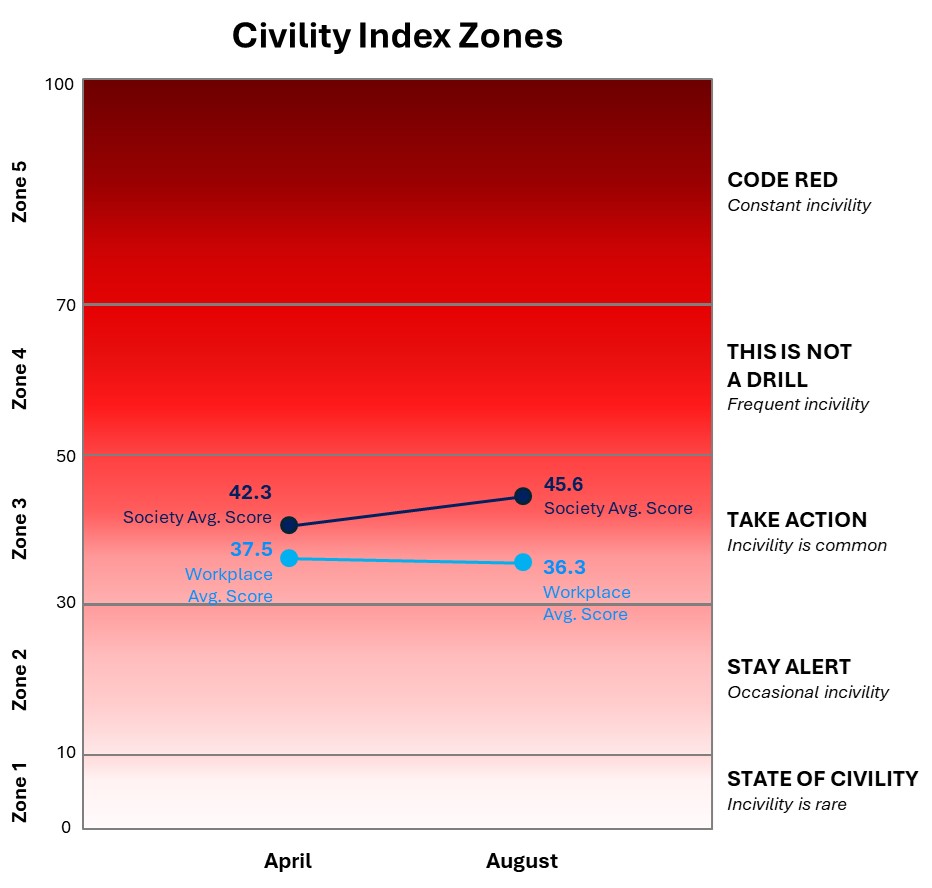In an era marked by increasing social discord, business leaders have a unique opportunity—and responsibility—to create workplaces that serve as bastions of civility. As we approach the 2024 presidential election, a time when societal tensions often reach their peak, this imperative becomes even more critical.
The Rising Tide of Incivility
Q3 2024 data from the SHRM Civility Index paints a concerning picture. Nearly three-quarters (74%) of U.S. workers report personally experiencing or witnessing acts of incivility over the past month. This trend isn’t confined to society at large; it’s seeping into our workplaces. U.S. workers collectively experienced or witnessed a total of 71 million instances of incivility each day in the workplace.
The most prevalent uncivil behaviors in the workplace are intentional interruptions, rudeness, and gossiping. While these may seem minor in isolation, their cumulative effect is far from trivial. One of the most insidious aspects of incivility is its self-perpetuating nature. The SHRM Civility Index reveals that workers who experience incivility are more likely to commit uncivil acts themselves, both in and out of the workplace. This creates a vicious cycle that, if left unchecked, can poison the entire organizational culture.
The impact of incivility on productivity and organizational health is staggering. Each incident of incivility results in an average productivity loss of 31 minutes. When aggregated across the U.S. workforce, this translates to a daily productivity loss of over $1.2 billion. Factor in absenteeism due to incivility, and the total cost to U.S. organizations balloons to more than $2 billion per day. These numbers are not only alarming but also unsustainable.
On the other hand, a civil workplace isn’t just more pleasant—it’s more productive and more likely to retain top talent. U.S. workers who personally experienced or witnessed incivility at work reported an average productivity loss of approximately 31 minutes per occurrence (31.27 minutes). Over one-third of U.S. workers would accept a pay cut (averaging 12% of their salary) to work in an environment free from incivility.
The Current State of Civility
In August 2024, U.S. workers scored an average of 45.6 out of 100 on the Society-level Civility Index, up from 42.3 in April, reflecting an increase in incivility experienced or witnessed in daily life. In the workplace, the average score was 36.3 out of 100, down from 37.5 in April, indicating slightly improved conditions . Both scores fall into Zone 3, suggesting moderate levels of incivility and highlighting the need for organizational intervention to prevent further deterioration.
SHRM’s data also shows that the acts of incivility experienced or witnessed by U.S. workers are most often influenced by differences in opinions on social issues, generational gaps, political viewpoints, racial or ethnic backgrounds, and perceptions of the current state and direction of U.S. society and the economy.

Impact of Civility Index Zones
A toxic work environment created by rampant incivility can drive away top talent and hinder innovation and collaboration. Data SHRM released in May shows this can manifest in a variety of ways, including:
- Organizational Culture: Workers in Zone 3 are 3.5 times more likely to rate their organization’s culture as poor compared to those in Zone 1 (22% versus 6%).
- Inclusion: Workers in Zone 3 are 2.5 times more likely to feel excluded (21% versus 8%).
- Job Turnover: Those in Zone 3 are significantly more likely to consider leaving their job within the next year (32% versus 18%).
- Voice Safety: Workers in Zone 3 are more than twice as likely to feel unsafe expressing concerns (27% versus 12%).
- Job Indifference: They are nearly three times as likely to be indifferent about their job performance (20% versus 6%).
- Physical Reactions: Job-induced physical reactions such as headaches or fatigue are more common in Zone 3 (36% versus 11%).
- Work/Life Balance: Poor work/life balance is reported 2.5 times more frequently in Zone 3 (22% versus 8%).
- Life Satisfaction: Dissatisfaction with everyday life is nearly doubled in Zone 3 (20% versus 11%).
The Workplace as a Microcosm of Society
Workplaces represent one of the few remaining environments where people from diverse backgrounds and perspectives regularly interact. This presents both a challenge and an opportunity. On one hand, this diversity can lead to friction if not managed properly. On the other hand, it provides a unique platform to model and foster civility.
Despite the rise in incivility, 74% of U.S. workers believe that people in their workplace are generally civil, compared to just 42% who say the same about people in society. Workplaces can have a special role in society, giving workers a reprieve from broader incivility and instilling values that can improve social discourse overall. That’s why it’s so important that business leaders step up and lead the charge to improve civility standards.
The Role of Leadership in Cultivating Civility
As with all culture-related initiatives, the tone is set at the top. Business leaders have a significant influence on workplace dynamics, and they must be intentional about promoting civility. This includes modeling respectful behavior, setting clear expectations for employee conduct, and addressing incidents of incivility promptly and transparently. When employees feel valued and supported, they are less likely to engage in or tolerate uncivil behavior.
Unfortunately, around two-thirds of workers believe their managers prioritize business objectives over how people are treated at work, and 62% report that they’ve seen a manager ignore acts of incivility. This sends a dangerous message that incivility is tolerated and even acceptable in the workplace.
By intentionally cultivating an inclusive environment where diverse perspectives are valued and respected, businesses can not only decrease incidents of incivility but also foster greater innovation, collaboration, and productivity. This requires setting clear expectations, modeling respectful behavior, and holding individuals accountable for their actions. It also means providing training and resources to help employees navigate difficult situations and communicate effectively.
Looking Ahead: Civility as a Competitive Advantage
As we approach the 2024 election and beyond, organizations that prioritize civility will likely find themselves with a significant competitive advantage. They’ll be better positioned to attract and retain top talent, foster innovation, and maintain productivity in the face of external pressures.
The challenge for business leaders is clear: Create workplaces that serve as refuges from the rising tide of incivility in the U.S. By doing so, they not only enhance their organization’s performance but also contribute to a more civil society. In today’s polarized world, that’s a goal worth pursuing with vigor and determination.
An organization run by AI is not a futuristic concept. Such technology is already a part of many workplaces and will continue to shape the labor market and HR. Here's how employers and employees can successfully manage generative AI and other AI-powered systems.




